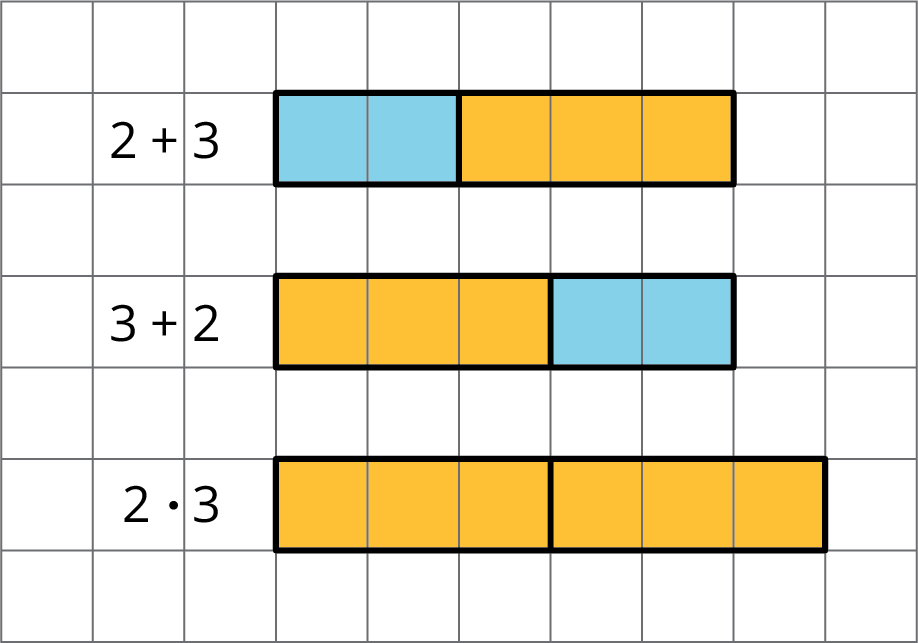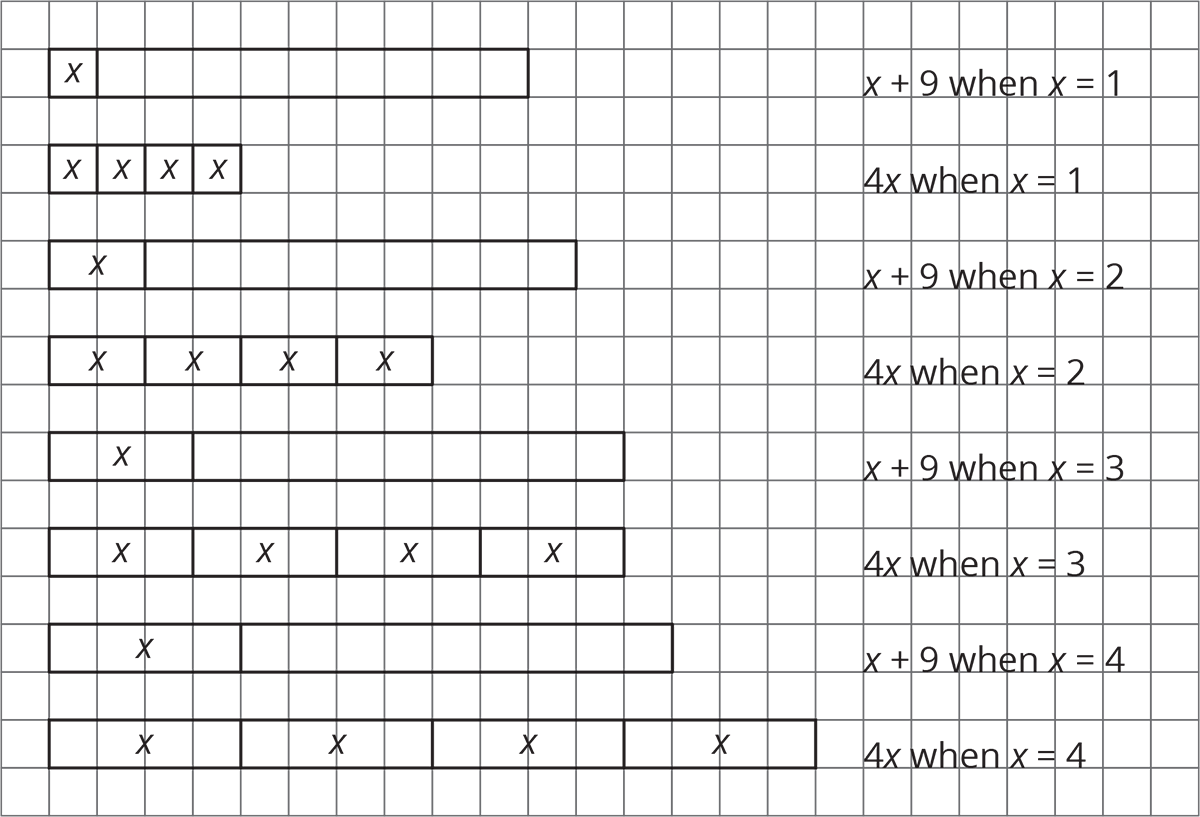Lesson 8
Equal and Equivalent
8.1: Algebra Talk: Solving Equations by Seeing Structure (5 minutes)
Warm-up
In this algebra talk, students recall how to solve equations by considering what number can be substituted for the variable to make the equation true. (Note: \(x^2=49\) of course has another solution if we allow solutions to be negative, but students haven't studied negative numbers yet, and don't study operations with negative numbers until grade 7, so it is unlikely to come up.)
Launch
Display one problem at a time. Give students 30 seconds of quiet think time for each problem and ask them to give a signal when they have an answer and a strategy. Keep all problems displayed throughout the talk. Follow with a whole-class discussion.
Supports accessibility for: Memory; Organization
Student Facing
Find a solution to each equation mentally.
\(3 + x = 8\)
\(10 = 12 - x\)
\(x^2 = 49\)
\(\frac13 x = 6\)
Student Response
For access, consult one of our IM Certified Partners.
Activity Synthesis
Ask students to share their strategies for each problem. Record and display their responses for all to see. To involve more students in the conversation, consider asking:
- “Who can restate ___’s reasoning in a different way?”
- “Did anyone have the same strategy but would explain it differently?”
- “Did anyone solve the problem in a different way?”
- “Does anyone want to add on to _____’s strategy?”
- “Do you agree or disagree? Why?”
Design Principle(s): Optimize output (for explanation)
8.2: Using Diagrams to Show That Expressions are Equivalent (20 minutes)
Activity
Students use diagrams to show that expressions can be equivalent or expressions can be equal for only one value of their variable. Working through these tape diagrams with small whole numbers, where students can count grids and use lengths to check their results, allows students to begin to generalize about equal and equivalent expressions.
Launch
Provide access to graph paper. Ask students to draw diagrams that show:
\(2+3=3+2\)
\(2+3\) does not equal \(2 \boldcdot 3\)

We can tell that \(2+3\) and \(3+2\) are equal because the length of the diagrams represent the value of each expression, and the diagrams are the same length. We can tell that \( 2\boldcdot 3\) is not equal to these because this value is represented by the length of its diagram, and it's not the same length as the others. \(2+3\) and \(3+2\) are examples of expressions that are not identical, but are equal. Another example students have seen of this phenomenon are fractions like \(\frac12\) and \(\frac36\), which are not identical but equal.
When we start talking about expressions that have letters in them, the language gets more complicated, because expressions can be equal or not equal depending on the value the letter represents.
Arrange students in groups of 2. Ask students to work independently on each question and then check in with their partner, discussing and resolving any disagreements. Allow 15 minutes to work and share responses with a partner, followed by a whole-class discussion.
Supports accessibility for: Memory; Conceptual processing
Student Facing
Here is a diagram of \(x+2\) and \(3x\) when \(x\) is 4. Notice that the two diagrams are lined up on their left sides.

In each of your drawings below, line up the diagrams on one side.
-
Draw a diagram of \(x+2\), and a separate diagram of \(3x\), when \(x\) is 3.

-
Draw a diagram of \(x+2\), and a separate diagram of \(3x\), when \(x\) is 2.

-
Draw a diagram of \(x+2\), and a separate diagram of \(3x\), when \(x\) is 1.

-
Draw a diagram of \(x+2\), and a separate diagram of \(3x\), when \(x\) is 0.

- When are \(x+2\) and \(3x\) equal? When are they not equal? Use your diagrams to explain.
-
Draw a diagram of \(x+3\), and a separate diagram of \(3+x\).
- When are \(x+3\) and \(3+x\) equal? When are they not equal? Use your diagrams to explain.
Student Response
For access, consult one of our IM Certified Partners.
Activity Synthesis
For the first sets of diagrams, if we consider \(x+2=3x\), we can see that this is true when \(x\) is 1, but not for the other values of \(x\) that we tried. For the second set of diagrams, if we consider \(x+3 = 3+x\) we can see that this equation is always going to be true no matter what the value of \(x\) is. We call \(x+3\) and \(3+x\) equivalent expressions, because their values are equal no matter what the value of \(x\) is.
Design Principle(s): Maximize meta-awareness
8.3: Identifying Equivalent Expressions (10 minutes)
Activity
In this activity, students apply what they know about the meaning of operations and their properties to understand what is meant by “equivalent expressions.” The focus is more on building that understanding than it is about doing all the types they eventually need to be able to do.
It is expected that students will reason using what they know about operations on numbers and potentially use diagrams. For example they learned earlier this year that something \(\div \frac13\) is equivalent to that same thing \(\boldcdot 3\). They can also reason that they know for example that \(4+4+4=3\boldcdot 4\), so \(a+a+a=3a\).
Launch
Allow students 5 minutes of quiet work time, followed by a whole-class discussion.
Student Facing
Here is a list of expressions. Find any pairs of expressions that are equivalent. If you get stuck, try reasoning with diagrams.
\(a+3\)
\(a+a+a\)
\(a \div \frac13\)
\(a \boldcdot 3\)
\(\frac13 a\)
\(3a\)
\(\frac{a}{3}\)
\(1a\)
\(a\)
\(3+a\)
Student Response
For access, consult one of our IM Certified Partners.
Student Facing
Are you ready for more?
Below are four questions about equivalent expressions. For each one:
- Decide whether you think the expressions are equivalent.
- Test your guess by choosing numbers for \(x\) (and \(y\), if needed).
- Are \(\dfrac{x \boldcdot x \boldcdot x \boldcdot x}{x}\) and \(x \boldcdot x \boldcdot x\) equivalent expressions?
- Are \(\dfrac{x + x + x + x}{x}\) and \(x + x + x\) equivalent expressions?
- Are \(2(x+y)\) and \(2x + 2y\) equivalent expressions?
- Are \(2xy\) and \(2x \boldcdot 2y\) equivalent expressions?
Student Response
For access, consult one of our IM Certified Partners.
Activity Synthesis
Invite students to share their pairs and reasoning. Include students who used diagrams.
Supports accessibility for: Language; Social-emotional skills; Attention
Design Principle(s): Optimize output (for generalization); Cultivate conversation
Lesson Synthesis
Lesson Synthesis
The purpose of the discussion is to ensure students understand what is meant by equivalent expressions and how they are different from expressions that are just equal for a given value of their variable. Consider giving them some equivalent expressions, and ask if they can explain why they are equivalent without drawing diagrams. Examples:
- \(x\) and \(x\boldcdot 1\)
- \(x+1\) and \(1+x\)
- \(x \boldcdot 3\) and \(x\)
- \(x\) and \(x+0\)
- \(x+x+x\) and \(3x\)
- \(x \div 4\) and \(\frac14 x\)
8.4: Cool-down - Decisions About Equivalence (5 minutes)
Cool-Down
For access, consult one of our IM Certified Partners.
Student Lesson Summary
Student Facing
We can use diagrams showing lengths of rectangles to see when expressions are equal. For example, the expressions \(x+9\) and \(4x\) are equal when \(x\) is 3, but are not equal for other values of \(x\).

Sometimes two expressions are equal for only one particular value of their variable. Other times, they seem to be equal no matter what the value of the variable.
Expressions that are always equal for the same value of their variable are called equivalent expressions. However, it would be impossible to test every possible value of the variable. How can we know for sure that expressions are equivalent? We use the meaning of operations and properties of operations to know that expressions are equivalent. Here are some examples:
- \(x+3\) is equivalent to \(3+x\) because of the commutative property of addition.
- \(4\boldcdot {y}\) is equivalent to \(y\boldcdot 4\) because of the commutative property of multiplication.
- \(a+a+a+a+a\) is equivalent to \(5\boldcdot {a}\) because adding 5 copies of something is the same as multiplying it by 5.
- \(b\div3\) is equivalent to \(b \boldcdot {\frac13}\) because dividing by a number is the same as multiplying by its reciprocal.
In the coming lessons, we will see how another property, the distributive property, can show that expressions are equivalent.